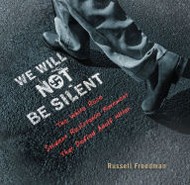What would it be like to be a teenage, boy-crazy, Jewish young woman in the 1940s? The idols of the time were Frank Sinatra, Ginger Rogers, Fred Astaire, and Clark Gable. Laundry was being pushed through the wringer, scarves were being knitted for the soldiers overseas, and scrap metal and tin cans were being saved to make guns. Negroes (the term of the era) were being lynched in the United States and Jews were being exterminated in Germany (although you would need to search the back pages of the newspaper to know this).
Living in a small town, Janet is the only child of a Jewish family who has tried to assimilate. Protected as much as possible by parents who have suffered as Jews in Europe, she grows up thinking that she is like all the other girls.
It is only after her visit to her aunt in a larger city that she is exposed to personal anti-Semitism. She goes out with a young man named Rudy, who has recently arrived from Germany. A refugee from Hitler, he is in the army training to be a German language interpreter. Haunted by the loss of his sister who has “disappeared” (a euphemism for being killed by the Nazis), the young man shares his pain with Janet. The young woman listens sympathetically and agrees to write to him.
After this and other encounters, Janet can hardly wait to return home where she is sure this kind of discrimination and persecution do not exist. Eventually Janet must wake up to the reality that she cannot escape bigotry and hatred so easily. Through interactions with her peers and the unraveling of some family secrets, she learns to accept herself and learns much about the world around her.
Because this book addresses World War II from the perspective of an American Jewish teenager, it is a welcome and valuable addition to the genre. Recommended for ages 12 – 17.





